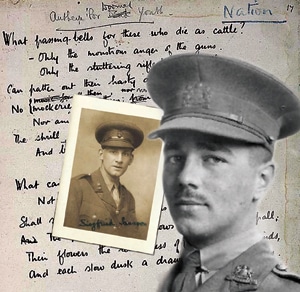

Owen’s poetry is remarkable not only for its content, but also for its use of half rhyme and assonance instead of full rhyme: a style that he is credited with popularizing. In “Anthem for Doomed Youth,” Owen replaces heroic songs and music with the terrifying sounds of battle, and he explores the dread of waiting for something to happen in the poem “Exposure.” In “A Parable of the Old Men and the Young,” Owen rewrites the ending of the Bible story of Abraham and Isaac, implicitly questioning the motives of the older men who send young men to their deaths. In the poem, Owen challenges that view with a description of a poisonous gas attack on soldiers in the trenches. The title of his poem “Dulce et Decorum est” is a reference to a quotation by the Latin writer Horace: “Dulce et decorum est pro patria mori” (roughly translated, “It is sweet and proper to die for your country”). Along with his friend and fellow British poet Siegfried Sassoon, Owen wrote about the realities of war in a way that was unfamiliar to audiences of the time. Owen’s experiences in the trenches, however, shaped his much grimmer view of war.

Many previous British poets had focused on the glory of war. Wilfred Edward Salter Owen is one of the most respected poets of World War I, which is an impressive feat for someone who wrote almost all of his poems between August 1917 and September 1918.


 0 kommentar(er)
0 kommentar(er)
